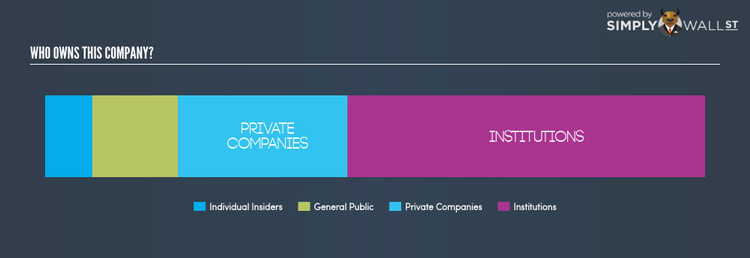Who Are The Major Shareholders Of Tanfield Group plc (LON:TAN)?

In this article, I’m going to take a look at Tanfield Group plc’s (AIM:TAN) latest ownership structure, a non-fundamental factor which is important, but remains a less discussed subject among investors. Ownership structure has been found to have an impact on shareholder returns in both short- and long-term. Since the same amount of capital coming from an activist institution and a passive mutual fund has different implications on corporate governance, it is a useful exercise to deconstruct TAN’s shareholder registry.
Check out our latest analysis for Tanfield Group
Institutional Ownership
Institutions account for 54.06% of TAN’s outstanding shares, a significant enough holding to move stock prices if they start buying and selling in large quantities, especially when there are relatively small amounts of shares available on the market to trade. These moves, at least in the short-term, are generally observed in an institutional ownership mix comprising of active stock pickers, in particular levered hedge funds, which can cause large price swings. For TAN shareholders, the potential of this type of share price volatility shouldn’t be as concerning as hedge fund ownership is is not significant,indicating few chances of such sudden price moves. While that hardly seems concerning, I will explore further into TAN’s ownership type to find out how it can affect the company’s investment profile.
Insider Ownership
Insiders form another group of important ownership types as they manage the company’s operations and decide the best use of capital. Insider ownership has been linked to better alignment between management and shareholders. With 7.25% ownership, TAN insiders is an important ownership type. An insider stake of this level indicates that executives are highly aligned with the shareholders as both stand to gain when the value of the company rises. It may be interesting to see what insiders have been doing with their shares lately. Insiders buying shares can be a positive indicator of future performance, but a selling decision can be simply driven by personal financial needs.
General Public Ownership
The general public holds a substantial 12.98% stake in TAN, making it a highly popular stock among retail investors. This size of ownership gives retail investors collective power in deciding on major policy decisions such as executive compensation, appointment of directors and acquisitions of businesses. This level of ownership gives retail investors the power to sway key policy decisions such as board composition, executive compensation, and potential acquisitions. This is a positive sign for an investor who wants to be involved in key decision-making of the company.
Private Company Ownership
Another group of owners that a potential investor in TAN should consider are private companies, with a stake of 25.70%. While they invest more often due to strategic interests, an investment can also be driven by capital gains through share price appreciation. With this size of ownership in TAN, this ownership class can affect the company’s business strategy. As a result, potential investors should further explore the company’s business relations with these companies and find out if they can affect shareholder returns in the long-term.
Next Steps:
TAN’s considerably high level of institutional ownership calls for further analysis into its margin of safety. This is to avoid getting trapped in a sustained sell-off that is often observed in stocks with this level of institutional participation. However, ownership structure should not be the only determining factor when you’re building an investment thesis for TAN. Rather, you should be looking at fundamental drivers such as Tanfield Group’s past track record and financial health. I highly recommend you to complete your research by taking a look at the following:
Financial Health: Is TAN’s operations financially sustainable? Balance sheets can be hard to analyze, which is why we’ve done it for you. Check out our financial health checks here.
Past Track Record: Has TAN been consistently performing well irrespective of the ups and downs in the market? Go into more detail in the past performance analysis and take a look at the free visual representations of TAN’s historicals for more clarity.
Other High-Performing Stocks: Are there other stocks that provide better prospects with proven track records? Explore our free list of these great stocks here.
NB: Figures in this article are calculated using data from the last twelve months, which refer to the 12-month period ending on the last date of the month the financial statement is dated. This may not be consistent with full year annual report figures.
To help readers see pass the short term volatility of the financial market, we aim to bring you a long-term focused research analysis purely driven by fundamental data. Note that our analysis does not factor in the latest price sensitive company announcements.
The author is an independent contributor and at the time of publication had no position in the stocks mentioned.

